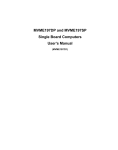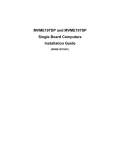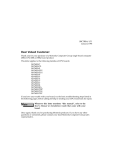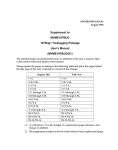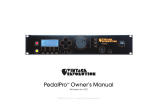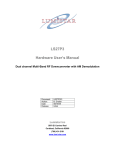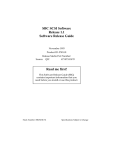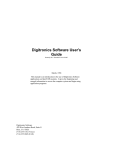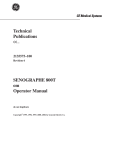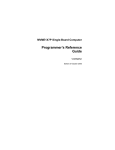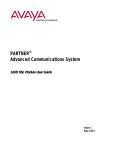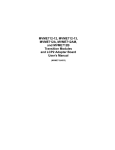Download Supplement to MVME197LE Single Board Computer User's Manual
Transcript
MVME197LE/D2A1 May 1994 Supplement to MVME197LE Single Board Computer User’s Manual (MVME197LE/D2) The attached pages are replacements for the corresponding pages in the manual. Place this page behind the title page of the manual as a record of this change. Please replace the pages according to the following table: Replace Old v/vi, 1-1/1-2, 3-1/3-2 through 3-7/3-8, 3-13/3-14, 4-3/4-4, A-1/A-2, A-3/A-4 With New v/vi, 1-1/1-2, 3-1/3-2 through 3-7/3-8, 3-13/3-14, 4-3/4-4, A-1/A-2, A-3/A-4 ❏ A vertical bar (|) in the margin of a replacement page indicates a text change or addition. ❏ The supplement number is shown at the bottom of each replacement page. Notice While reasonable efforts have been made to assure the accuracy of this document, Motorola, Inc. assumes no liability resulting from any omissions in this document, or from the use of the information obtained therein. Motorola reserves the right to revise this document and to make changes from time to time in the content hereof without obligation of Motorola to notify any person of such revision or changes. No part of this material may be reproduced or copied in any tangible medium, or stored in a retrieval system, or transmitted in any form, or by any means, radio, electronic, mechanical, photocopying, recording or facsimile, or otherwise, without the prior written permission of Motorola, Inc. Restricted Rights Legend If the documentation contained herein is supplied, directly or indirectly, to the U.S. Government, the following notice shall apply unless otherwise agreed to in writing by Motorola, Inc. Use, duplication, or disclosure by the Government is subject to restrictions as set forth in subparagraph (c)(1)(ii) of the Rights in Technical Data and Computer Software clause at DFARS 252.227-7013. Motorola, Inc. Computer Group 2900 South Diablo Way Tempe, Arizona 85282-9602 Related Documentation The following publications are applicable to the MVME197LE module and may provide additional helpful information. If not shipped with this product, they may be purchased by contacting your Motorola sales office. Document Title Motorola Publication Number MVME197LE, MVME197DP, and MVME197SP Single Board Computers Programmer’s Reference Guide MVME197PG MVME197BUG 197Bug Debugging Package User’s Manual MVME197BUG MVME197BUG 197Bug Diagnostic Firmware User’s Manual MVME197DIAG MVME712M Transition Module and P2 Adapter Board User’s Manual MVME712M MVME712-12, MVME712-13, MVME712A, MVME712AM, MVME712A and MVME712B Transition Module and LCP2 Adapter Board User’s Manual MC68040/MC68EC040/MC68CL040 Microprocessor User’s Manual M68040UM/AD MC88110 Second Generation RISC Microprocessor User’s Manual MC88110UM/AD N ote Although not shown in the above list, each Motorola Computer Group manual publication number is suffixed with characters which represent the revision level of the document, such as “/D2” (the second revision of a manual); a supplement bears the same number as the manual but has a suffix such as “/A1” (the first supplement to the manual). To further assist your development effort, Motorola has collected user’s manuals for each of the peripheral controllers used on the MVME197 module series and other boards from the suppliers. This bundle includes manuals for the following: 68-1X7DS for use with the MVME197 series of Single Board Computers. NCR 53C710 SCSI Controller Data Manual and Programmer’s Guide Intel i82596 Ethernet Controller User’s Manual Cirrus Logic CD2401 Serial Controller User’s Manual SGS-Thompson MK48T08 NVRAM/TOD Clock Data Sheet The following non-Motorola publications may also be of interest and may be obtained from the sources indicated. The VMEbus Specification is contained in ANSI/IEEE Standard 1014-1987. ANSI/IEEE Std 1014-1987 Versatile Backplane Bus: VMEbus The Institute of Electrical and Electronics Engineers, Incorporated Publication and Sales Department 345 East 47th Street New York, New York 10017-2633 Telephone: 1-800-678-4333 ANSI Small Computer System Interface-2 (SCSI-2), Draft Document X3.131-198X, Revision 10c Global Engineering Documents P.O. Box 19539 Irvine, California 92713-9539 Telephone (714) 979-8135 GENERAL INFORMATION 1 Introduction This user’s manual provides general information, preparation for use and installation instructions, operating instructions, and a functional description for the MVME197LE version of the MVME197 series of single board computers. General Description The MVME197LE module is a double-high VMEmodule based on the MC88110 RISC (Reduced Instruction Set Computing) microprocessor. The MVME197LE has 32/64MB of DRAM, 1MB of FLASH memory, 8KB of static RAM (with battery backup), a time of day clock (with battery backup), an Ethernet transceiver interface, four serial ports with EIA-232-D interface, six tick timers, a watchdog timer, 128/256KB of BOOT ROM, a SCSI bus interface with DMA (Direct Memory Access), a Centronics printer port, an A16/A24/A32/D8/D16/D32 VMEbus master/slave interface, and a VMEbus system controller. Input/Output (I/O) signals are routed through the MVME197LE’s backplane connector P2. A P2 Adapter Board or LCP2 Adapter board routes the signals and grounds from connector P2 to an MVME712 series transition module. The MVME197LE supports the MVME712M, MVME712A, MVME712AM, and MVME712B transition boards (referred to here as the MVME712X, unless separately specified). The MVME197LE also supports the MVME712-12 and MVME712-13 (referred to as the MVME712-XX, unless separately specified). These transition boards provide configuration headers, serial port drivers, and industry standard connectors for the I/O devices. The MVME197LE modules have eight ASIC devices (Application-Specific Integrated Circuits) described in the following order: BusSwitch, DCAM, ECDM, PCC2, and VME2. The BusSwitch ASIC provides an interface between the processor bus (MC88110 bus) and the local peripheral bus (MC68040 compatible bus). Refer to the MVME197LE block diagram (Figure 1-1). It provides bus arbitration for the MC88110 bus and serves as a seven level interrupt handler. It has programmable map decoders for both busses, as well as write post buffers on each, two tick timers, and four 32-bit general purpose registers. MVME197LE/D2A1 1-1 1 General Information N ote For the MVME197 series, the term Local Bus, as used in other MVME1xx Single Board Computer series, is referred to as the Local Peripheral Bus. The DCAM (DRAM Controller and Address Multiplexer) ASIC provides the address multiplexers and RAS/CAS/WRITE control for the DRAM as well as data control for the ECDM. The ECDM (Error Correction and Data Multiplexer) ASIC multiplexes between four data paths on the DRAM array. Since the device handles 16 bits, four such devices are required on the MVME197LE to accommodate the 64-bit data bus of the MC88110 microprocessor. Single-bit error correction and double-bit detection is performed in the ECDM. The PCCchip2 (Peripheral Channel Controller) ASIC provides two tick timers and the interface to the LAN chip, the SCSI chip, the serial port chip, the printer port, and the BBRAM (Battery Backup RAM). The VMEchip2 ASIC provides a VMEbus interface. The VMEchip2 includes two tick timers, a watchdog timer, programmable map decoders for the master and slave interfaces, and a VMEbus to/from the local peripheral bus DMA controller, a VMEbus to/from the local peripheral bus non-DMA programmed access interface, a VMEbus interrupter, a VMEbus system controller, a VMEbus interrupt handler, and a VMEbus requester. The local peripheral bus to VMEbus transfers can be D8, D16, or D32. VMEchip2 DMA transfers to the VMEbus, however, can be 64 bits wide as Block Transfer (BLT). Features These are some of the major features of the MVME197LE single board computer: 1-2 ❏ MC88110 RISC Microprocessor ❏ 32 or 64 megabytes of 64-bit Dynamic Random Access Memory (DRAM) with error correction ❏ 1 megabyte of FLASH memory ❏ Six status LEDs (FAIL, RUN, SCON, LAN, SCSI, and VME) ❏ 8 kilobytes of Static Random Access Memory (SRAM) and Time of Day (TOD) clock with Battery Backup RAM (BBRAM) ❏ Two push-button switches (ABORT and RESET) MVME197LE/D2A1 OPERATING INSTRUCTIONS 3 Introduction This chapter provides the necessary information to use the MVME197LE VMEmodule in a system configuration. This includes controls and indicators, memory maps, and software initialization of the module. Controls and Indicators The MVME197LE Single Board Computer has two push-button switches (ABORT and RESET) and six LED (Light Emitting Diode) indicators (FAIL, SCON, RUN, LAN, VME, and SCSI), all located on the front panel of the module. ABORT Switch S2 When enabled by software, the front panel ABORT switch (S2) generates an NMI (Non-Maskable Interrupt) type interrupt at a user-programmable level. It is normally used to abort program execution and return to the 197Bug debugger. Refer to the VMEchip2 chapter of the MVME197LE, MVME197DP, and MVME197SP Single Board Computers Programmer’s Reference Guide for more information. RESET Switch S3 The RESET switch (S3) will reset all the onboard devices and drive the SYSRESET* signal if the MVME197LE module is the system controller. The RESET switch (S3) will reset all the onboard devices, with the exception of the DCAM and ECDM, if the MVME197LE module is not the system controller. The VMEchip2 generates the SYSRESET* signal. The BusSwitch combines the local reset and the reset switch to generate a local board reset. Refer to the Reset Driver section in the VMEchip2 chapter of the MVME197LE, MVME197DP, and MVME197SP Single Board Computers Programmer’s Reference Guide for more information. The BusSwitch receives the reset switch signal, debounces it and combines with the reset signal from the VMEchip2 to generate a board reset signal. The VMEchip2 includes both a global and a local reset driver. When the chip operates as the VMEbus system controller, the reset driver provides a global system reset by asserting the VMEbus signal SYSRESET*. A SYSRESET* may MVME197LE/D2A1 3-1 Operating Instructions be generated by the RESET switch, a power up reset, a watchdog timeout, or by a control bit in the LCSR. SYSRESET* remains asserted for at least 200 msec, as required by the VMEbus specification. 3 Similarly, the VMEchip2 provides an input signal and a control bit to initiate a local reset operation. By setting a control bit, software can maintain a board in a reset state, disabling a faulty board from participating in normal system operation. The local reset driver is enabled even when the VMEchip2 is not the system controller. A local reset may be generated by the RESET switch, a power up reset, a watchdog timeout, a VMEbus SYSRESET*, or a control bit in the GCSR. Front Panel Indicators (DS1-DS6) The six LEDs on the MVME197LE front panel are: FAIL, SCON, RUN, LAN, VME, and SCSI. 1. The yellow FAIL LED (DS1) is lit when the BRDFAIL signal line is active. 2. The green SCON LED (DS2) is lit when the VMEchip2 is the VMEbus system controller. 3. The green RUN LED (DS3) is lit when the MC88110 bus MC* pin is low. 4. The green LAN LED (DS4) lights when the LAN chip is the local peripheral bus master. 5. The green VME LED (DS5) lights when the board is using the VMEbus or when the board is accessed by the VMEbus. 6. The green SCSI LED (DS6) lights when the SCSI chip is the local peripheral bus master. Memory Maps There are three points of view for the memory maps: 1) the mapping of all resources as viewed by the Processor Bus (MC88110 bus), 2) the mapping of onboard/off-board resources as viewed from the Local Peripheral Bus (MC68040 compatible bus), and 3) the mapping of onboard resources as viewed by VMEbus Masters (VMEbus memory map). Processor Bus Memory Map Care should be taken, since all three maps are programmable. It is recommended that direct mapping from the Processor Bus to the Local Peripheral Bus be used. 3-2 MVME197LE/D2A1 Memory Maps The memory maps of MVME197LE devices are provided in the following tables. Table 3-1 is the entire map from $00000000 to $FFFFFFFF. Many areas of the map are user-programmable, and suggested uses are shown in the table. This is assuming no address translation is used between the processor and local peripheral bus and between the local peripheral bus and VMEbus. The cache inhibit function is programmable in the MC88110. The onboard I/O space must be marked cache inhibit and serialized in its page table. Table 3-2 further defines the map for the local devices. Table 3-1. Processor Bus Memory Map Address Range Devices Accessed $00000000 - (DRAMSIZE -1) User Programmable (Onboard DRAM) DRAMSIZE - $FF7FFFFF $FF800000 - $FFBFFFFF Size D64 DRAMSIZE N 1 3GB ? 2,3 4MB N 5 User Programmable D32/D16 (VMEbus) Flash Memory Software Cache Notes Inhibit Port Size D32 $FFC00000 - $FFEFFFFF reserved --- 3MB --- 4 $FFF00000 - $FFFEFFFF Local Devices (Refer to next table) D32-D8 1MB Y --- $FFFF0000 - $FFFFFFFF User Programmable D32/D16 (VMEbus A16) 64KB ? 1,3 N otes 1. This area is user-programmable. The suggested use is shown in the table. The DRAM decoder is programmed in the DCAM through the ECDM I2C bus interface. The Processor Bus to Local Peripheral Bus and the Local Peripheral Bus to Processor Bus decoders are programmed in the BusSwitch. The Local Peripheral to VMEbus (master) and VMEbus to Local Peripheral Bus (slave) decoders are programmed in the VMEchip2. 2. Size is approximate. 3. Cache inhibit depends on devices in area mapped. 4. This area is not decoded. If these locations are accessed and the local peripheral bus timer is enabled, the cycle times out and is terminated by a TEA signal. 5. This area is user programmable via the BusSwitch. Default size is 4 megabytes. MVME197LE/D2A1 3-3 3 Operating Instructions The following table focuses on the Local Devices portion of the Memory Map. Table 3-2. Local Devices Memory Map 3 Address Range $FFF00000 $FFF01000 $FFF02000 $FFF03000 $FFF04000 $FFF05000 $FFF06000 $FFF07000 $FFF08000 $FFF40000 $FFF40100 $FFF40200 $FFF41000 $FFF42000 $FFF43000 $FFF44000 $FFF45000 $FFF46000 $FFF47000 $FFF48000 $FFF50000 $FFF70000 $FFF78000 $FFF80000 $FFFC0000 $FFFD0000- N otes $FFF00FFF $FFF01FFF $FFF02FFF $FFF03FFF $FFF04FFF $FFF05FFF $FFF06FFF $FFF07FFF $FFF3FFFF $FFF400FF $FFF401FF $FFF40FFF $FFF41FFF $FFF42FFF $FFF43FFF $FFF44FFF $FFF45FFF $FFF46FFF $FFF47FFF $FFF4FFFF $FFF6FFFF $FFF77FFF $FFF7FFFF $FFFBFFFF $FFFCFFFF $FFFEFFFF Devices Accessed Port Size BusSwitch ECDM (DCAM access) reserved reserved reserved reserved reserved User defined reserved VMEchip2 (LCSR) VMEchip2 (GCSR) reserved reserved PCCchip2 reserved reserved CD2401 (Serial Comm. Cont.) 82596CA (LAN) 53C710 (SCSI) reserved reserved reserved reserved DROM (BOOT ROM) MK48T08 (BBRAM,TOD Clk) reserved D64-D8 ----------------D32 D32-D8 ----D32-D8 ----D16-D8 D32 D32/D8 ----------D32-D8 --- Size 4KB 4KB 4KB 4KB 4KB 4KB 4KB 4KB 224KB 256B 256B 3.5KB 4KB 4KB 4KB 4KB 4KB 4KB 4KB 32KB 128KB 32KB 288KB 256KB 64KB 128KB Notes 1 1 4 4 4 4 4 4 4 1,2,3 1,2,3 4,5 4 1,2 4 3 1,2 1,2,6 1,2 4 4 4 4 7 1,2 4 1. For a complete description of the register bits, refer to the appropriate data sheet for the specific chip. For a more detailed memory map refer to the detailed peripheral device memory maps in the MVME197LE, MVME197DP, and MVME197SP Single Board Computers Programmer’s Reference Guide. 2. Address is the physical address going to the device. It is after the BusSwitch translation from the MC88110 address to the device seen address. 3-4 MVME197LE/D2A1 Memory Maps 3. Writes to the LCSR in the VMEchip2 must be 32 bits. LCSR writes of 8 or 16 bits terminate with a TEA signal. Writes to the GCSR may be 8, 16, or 32 bits. Reads to the LCSR and GCSR may be 8, 16, or 32 bits. 3 4. This area does not return an acknowledge signal. If the processor bus timeout timer is enabled, the access times out and is terminated by a TEA signal. 5. Size is approximate. 6. Port commands to the 82596CA must be written as two 16-bit writes: upper word first and lower word second. 7. DROM (BOOT ROM) appears at $0 following a local peripheral bus reset. The DROM appears at 0 until the DR0 bit is cleared in the PCCchip2. In addition, the ROM0 bit in the ROMCR register of the BusSwitch must be cleared before the DRAM is accessed. Detailed I/O Memory Maps Tables 3-3 through 3-14 give the detailed memory maps for the BusSwitch register, the ECDM CSR register, the DCAM (I2C) register, the VMEchip2 register, the PCCchip2 register, the printer register, the CD2401 Serial Port register, the Ethernet LAN register, the SCSI Controller register, and the BBRAM/TOD Clock register. MVME197LE/D2A1 3-5 Operating Instructions Table 3-3. BusSwitch Register Memory Map BusSwitch Base Address = $FFF00000 Offset 3 63 56 55 48 47 32 31 16 15 0 0 CHIPID CHIPREV GCSR IODATA IODIR 8 PSAR1 PEAR1 PSAR2 PEAR2 10 PSAR3 PEAR3 PSAR4 PEAR4 18 PTR1 PTSR1 PTR2 PTSR2 20 PTR3 PTSR3 PTR4 PTSR4 28 SSAR1 SEAR1 SSAR2 SEAR2 30 SSAR3 SEAR3 SSAR4 SEAR4 38 STR1 STSR1 STR2 STSR2 40 STR3 STSR3 STR4 STSR4 48 PAR1 50 PAR2 68 PAR4 SAR1 SAR2 BTIMER PADJUST PCOUNT 58 60 PAR3 WPPA ROMCR ABORT CPINT SAR3 PAL WPTPA WPPAT TCTRL1 TCTRL2 LEVEL MASK ISEL0 ISEL1 TINT1 TINT2 WPINT PALINT XINT VBASE 70 TCOMP1 TCOUNT1 78 TCOMP2 TCOUNT2 80 GPR1 GPR2 88 GPR3 GPR4 90 XCTAGS 100 XCCR VECTOR1 108 VECTOR2 VECTOR3 110 VECTOR4 VECTOR5 118 VECTOR6 VECTOR7 3-6 SAR4 MVME197LE/D2A1 MVME197LE/D2A1 Table 3-4. ECDM CSR Register Memory Map Sub-System Memory CSR Base Address = $FFF01000 Offset/Register: ECDM0 ECDM1 ECDM2 ECDM3 ADDR/REGISTER ADDR/REGISTER ADDR/REGISTER ADDR/REGISTER ADDR/REGISTER ADDR/REGISTER ADDR/REGISTER ADDR/REGISTER 00 / MEMCON0 01 / ECDMID0 02 / MEMCON1 03 / ECDMID1 04 / MEMCON2 05 / ECDMID2 06 / MEMCON3 07 / ECDMID3 08 / SYNSTAT0 09 / ERSTAT0 0A / SYNSTAT1 0B / ERSTAT1 0C / SYNSTAT2 0D / ERSTAT2 0E / SYNSTAT3 0F / ERSTAT3 10 / I2CON0 11 / I2STAT0 12 / I2CON1 13 / I2STAT1 14 / I2CON2 15 / I2STAT2 16 / I2CON3 17 / I2STAT3 18 / I2DATA0 19 / I2ADDR0 1A / I2DATA1 1B / I2ADDR1 1C / I2DATA2 1D / I2ADDR2 1E / I2DATA3 1F / I2ADDR3 D63 D56 D55 D48 D47 D40 D39 D32 D31 D24 D23 D16 D15 D8 D7 D0 ECDM register map of four ECDM devices in a 64-bit system. The byte offset address is shown next to each register. Memory Maps 3-7 3 Operating Instructions Table 3-5. DCAM (I2C) Register Memory Map DCAM (I2C) Base Address = $C0 (default) Offset 3 BIT 7 BIT 6 BIT 5 00 00 BIT 3 BIT 2 BIT 1 BIT 0 SL26 SL25 DISRAM ID Register 01 01 02 02 BIT 4 Version Register SL31 SL30 SL29 SL28 SL27 03 03 SH31 SH30 SH29 SH28 SH27 SH26 SH25 SCRUB1TIME 04 04 CASCLKSL CASCLK2 CASCLK1 PGMODE ONEBANK DRAMSIZ3 DRAMSIZ2 DRAMSIZ1 05 05 REF7 REF6 REF5 REF4 REF3 REF2 REF1 REF0 06 06 REFTAIL4 REFTAIL3 REFTAIL2 REFTAIL1 REF11 REF10 REF9 REF8 07 07 NOT USED NOT USED RDTAIL5 RDTAIL4 RDTAIL3 RDTAIL2 RDTAIL1 RTCLKSL 08 08 READACK7 READACK6 READACK5 READACK4 READACK3 READACK2 READACK1 INTRRUPT 09 09 NOT USED READOE6 READOE5 READOE4 READOE3 READOE2 READOE1 NOT USED 0A 10 FECCKSL BREADOE6 BREADOE5 BREADOE4 BREADOE3 BREADOE2 BREADOE1 PCGCLKSL 0B 11 PCHG7 PCHG6 PCHG5 PCHG4 PCHG3 PCHG2 PCHG1 PCHG0 0C 12 SLECDM5 SLECDM4 SLECDM3 SLECDM2 FLECDM4 FLECDM3 FLECDM2 FLECDM1 0D 13 NOT USED ERAMOE6 ERAMOE5 ERAMOE4 ERAMOE3 ERAMOE2 ERAMOE1 ROECLKSL 0D 14 NOT USED 0F 15 CSRTAIL7 RMWRMOE6 RMWRMOE5 RMWRMOE4 RMWRMOE3 RMWRMOE2 RMWRMOE1 CSRTAIL6 CSRTAIL5 CSRTAIL4 CSRTAIL3 CSRTAIL2 CSRTAIL1 RMWOE5 NOT USED 10 16 BWRTTL4 BWRTTL3 BWRTTL2 BWRTTL1 RMWOE4 RMWOE3 RMWOE2 RMWOE1 11 17 SECCLKSL RMWOCKSL BWRITE5 BWRITE4 BWRITE3 BWRITE2 BWRITE1 WRCLKSEL 12 18 NOT USED NOT USED RMW5 RMW4 RMW3 RMW2 RMW1 NOT USED 13 19 RMWTAIL7 RMWTAIL6 RMWTAIL5 RMWTAIL4 RMWTAIL3 RMWTAIL2 RMWTAIL1 RMWTLCSL 14 20 CBRDOE3 CBRDOE2 CBRDOE1 NOT USED CREADOE3 CREADOE2 CREADOE1 BWRTCSL 15 21 SC9 SC8 SC7 SC6 SC5 SC4 SC3 SC2 16 22 SC17 SC16 SC15 SC14 SC13 SC12 SC11 SC10 17 23 SC25 SC24 SC23 SC22 SC21 SC20 SC19 SC18 18 24 NOT USED SC32 SC31 SC30 SC29 SC28 SC27 SC26 19 25 NOT USED NOT USED NOT USED CBTAIL4 CBTAIL3 CBTAIL2 CBTAIL1 CBTLCKSL 1A 26 CSR7 CSR6 CSR5 CSR4 NOT USED NOT USED NOT USED NOT USED 1B 27 CSR15 CSR14 CSR13 CSR12 CSR11 CSR10 CSR9 CSR8 1C 28 CSR23 CSR22 CSR21 CSR20 CSR19 CSR18 CSR17 CSR16 1D 29 CSR31 CSR30 CSR29 CSR28 CSR27 CSR26 CSR25 CSR24 1E 30 NOT USED NOT USED BRDTAIL5 BRDTAIL4 BRDTAIL3 BRDTAIL2 BRDTAIL1 NOT USED BIT 7 BIT 6 BIT 5 BIT 4 BIT 3 BIT 2 BIT 1 BIT 0 1F 31 DCAM registers are only accessible/addressable on the DRAM sub-system I2C bus through the ECDM I2C interface. 3-8 MVME197LE/D2A1 MVME197LE/D2A1 Table 3-7. PCCchip2 Memory Map PCCchip2 LCSR Base Address = $FFF42000 OFFSET: D31 D30 D29 00 D28 D27 D26 D25 D24 D23 D22 D21 CHIP ID D20 D19 D18 D17 D16 CHIP REVISION D15 D14 TIC TIMER 1 COMPARE 08 TIC TIMER 1 COUNTER 0C TIC TIMER 2 COMPARE 10 TIC TIMER 2 COUNTER 18 PRESCALER COUNT GPI PLTY GPI E/L* GPI INT GPI IEN GPI ICLR SCC SCC RTRY PAR ERR ERR 1C SCC EXT ERR SCC LTO ERR GPI SCC SCLR SCC MDM SCC MDM SCC MDM D11 OVERFLOW COUNTER 2 PRESCALER CLOCK ADJUST GPI IRQ LEVEL D12 GIOE D10 D9 D8 D7 D6 D5 CPU MSTR FAST 040 INT BRAM EN 04 14 D13 DR0 GPO SCC MODEM IRQ LEVEL CLR OVF 2 COC 2 TIC 2 TIC2 INT TIC2 IEN TIC2 ICLR TIC TIMER 2 IRQ LEVEL SCC TX IRQ SCC TX IEN SCC TX AVEC SCC TRANSMIT IRQ LEVEL D4 D3 D2 D1 D0 CLR OVF 1 COC 1 TIC 1 VECTOR BASE OVERFLOW COUNTER 1 SCC SC1 SCC SC2 20 TIC1 INT TIC1 IEN TIC1 ICLR TIC TIMER 1 IRQ LEVEL SCC IRQ SCC IEN SCC AVEC SCC RECEIVE IRQ LEVEL SCC MODEM PIACK 24 SCC TRANSMIT PIACK LAN EXT ERR LAN LTO ERR 2C SCSI PAR ERR SCSI EXT ERR SCSI SCSI LTO SCLR ERR 30 PRTR PRTR PRTR PRTR PRTR ACK ACK ACK ACK ACK INT IEN ICLR PLTY E/L* PRTR ACK IRQ LEVEL 34 PRTR PRTR PRTR PRTR PRTR BSY BSY BSY BSY BSY INT IEN ICLR PLTY E/L* PRTR BSY IRQ LEVEL 38 SCC RECEIVE PIACK LAN PLTY LAN SCLR PRTR PRTR PRTR PRTR PRTR FLT FLT FLT FLT FLT PLTY E/L* INT IEN ICLR PRTR FAULT IRQ LEVEL LAN E/L* LAN INT LAN IEN LAN ICLR PRTR PRTR PRTR PRTR PRTR SEL SEL SEL SEL SEL PLTY E/L* INT IEN ICLR PRTR ANY INT LAN IRQ LEVEL LAN SC1 PRTR SEL IRQ LEVEL LAN SC2 LAN ERR INT LAN ERR IEN SCSI IRQ SCSI IEN LAN ERR IRQ LEVEL SCSI INT IRQ LEVEL PRTR PRTR PRTR PRTR PRTR PE PE PE PE PE PLTY E/L* INT IEN ICLR PRTR PRTR PRTR PRTR PRTR ACK FLT SEL PE BSY CHIP SPEED LAN ERR ICLR PRTR PE IRQ LEVEL PRTR PRTR PRTR PRTR PRTR DAT INP STB FAST MAN ENBL ASTB STB PRINTER DATA INTERRUPT IPL LEVEL 3C D31 D30 D29 D28 D27 D26 D25 D24 D23 D22 D21 D20 D19 D18 D17 D16 D15 D14 D13 D12 D11 D10 D9 D8 INTERRUPT MASK LEVEL D7 D6 D5 D4 D3 D2 D1 D0 3-13 Memory Maps 28 LAN PAR ERR 3 Operating Instructions Table 3-8. Printer Memory Map Printer ACK Interrupt Control Register 3 BIT NAME $FFF42030 31 30 29 28 27 26 25 24 PLTY E/L* INT IEN ICLR IL2 IL1 IL0 Printer FAULT Interrupt Control Register BIT NAME $FFF42031 23 22 21 0 19 18 17 16 PLTY E/L* INT IEN ICLR IL2 IL1 IL0 Printer SEL Interrupt Control Register BIT NAME $FFF42032 15 14 13 12 11 10 9 8 PLTY E/L* INT IEN ICLR IL2 IL1 IL0 Printer PE Interrupt Control Register BIT NAME $FFF42033 7 6 5 4 3 2 1 0 PLTY E/L* INT IEN ICLR IL2 IL1 IL0 Printer BUSY Interrupt Control Register BIT NAME $FFF42034 31 30 29 28 27 26 25 24 PLTY E/L* INT IEN ICLR IL2 IL1 IL0 Printer Input Status Register BIT NAME 15 14 $FFF42036 13 PINT 12 11 10 9 8 ACK FLT SEL PE BSY Printer Port Control Register BIT 7 6 $FFF42037 5 NAME 4 3 2 1 0 DOEN INP STB FAST MAN Printer Data Register (16 bits) BIT NAME $FFF4203A 15-0 PD15-PD0 Printer memory map is part of the PCCchip2 (refer to PCCchip2 Memory Map). 3-14 MVME197LE/D2A1 MVME197LE Functional Description BOOT ROM The board accommodates a 32-pin PLCC/CLCC ROM/EPROM referred to as BOOT ROM or DROM (Download ROM). It is organized as a 128K/256K x 8 device, but as viewed from the processor it looks like a 16K/32K x 64 memory. This memory is mapped starting at location $FFF80000, but after a local reset it is also mapped at location 0, providing a reset vector and bootstrap code for the processor. The DR0 bit in the General Control Register (GCR) of the PCCchip2 must be cleared to disable the BOOT ROM memory map at 0. FLASH Memory 1MB of FLASH memory is available on the board. FLASH memory works like EPROM, but can be erased and reprogrammed by software. It is organized as 32 bits wide, but to the processor it looks as 64 bits wide. It is mapped at location $FF800000. Reads can be of any size, including burst transfers, but writes are always 32 bits wide, regardless of the size specified for the transfer. For this reason, software should only use 32-bit write transfers. This memory is controlled by the BusSwitch, and the memory size, access time, and write enable capability can be programmed via the ROM Control Register (ROMCR) in the BusSwitch. The FLASH memory can be accessed from the processor bus only. It is not accessible from the local peripheral bus or VMEbus. Onboard DRAM The MVME197LE onboard DRAM (2 banks of 32MB memory, one optionally installed) is sized at 32MB using 1M x 4 devices and configured as 256 bits wide. The DRAM is four-way interleaved to efficiently support cache burst cycles. The DRAM is controlled by the DCAM and ECDM, and the map decoders in the DCAM can be programmed through the I2Cbus interface in the ECDM to accommodate different base address(es) and sizes. The onboard DRAM is not reset by a local peripheral bus reset. Refer to the DCAM and ECDM chapters in the MVME197LE, MVME197DP, and MVME197SP Single Board Computers Programmer’s Reference Guide for detailed programming information. Battery Backup RAM and Clock The MK48T08 RAM and clock chip is used on the MVME197LE. This chip provides a time of day clock, oscillator, crystal, power fail detection, memory write protection, 8KB of RAM, and a battery in one 28-pin package. The clock provides seconds, minutes, hours, day, date, month, and year in BCD 24-hour MVME197LE/D2A1 4-3 4 Functional Description format. Corrections for 28-, 29-, (leap year) and 30-day months are automatically made. No interrupts are generated by the clock. The MK48T08 is an 8-bit device; however the interface provided by the PCCchip2 supports 8-, 16-, and 32-bit accesses to the MK48T08. Refer to the PCCchip2 chapter in the MVME197LE, MVME197DP, and MVME197SP Single Board Computers Programmer’s Reference Guide and to the MK48T08 data sheet for detailed programming information. 4 VMEbus Interface The local peripheral bus to VMEbus interface, the VMEbus to local peripheral bus interface, and the local-VMEbus DMA controller functions on the MVME197LE are provided by the VMEchip2. The VMEchip2 can also provide the VMEbus system controller functions. Refer to the VMEchip2 chapter in the MVME197LE, MVME197DP, and MVME197SP Single Board Computers Programmer’s Reference Guide for detailed programming information. I/O Interfaces The MVME197LE provides onboard I/O for many system applications. The I/O functions include serial ports, a printer port, an Ethernet transceiver interface, and a SCSI mass storage interface. Serial Port Interface The CD2401 serial controller chip (SCC) is used to implement the four serial ports. The serial ports support the standard baud rates (110 to 38.4K baud). Serial port 4 also supports synchronous modes of operation. The four serial ports are different functionally because of the limited number of pins on the I/O connector. Serial port 1 is a minimum function asynchronous port. It uses RXD, CTS, TXD, and RTS. Serial ports 2 and 3 are full function asynchronous ports. They use RXD, CTS, DCD, TXD, RTS, and DTR. Serial port 4 is a full function asynchronous or synchronous port. It can operate at synchronous bit rates up to 64k bits per second. It uses RXD, CTS, DCD, RTS, and DTR. It also interfaces to the synchronous clock signal lines. Refer to the MVME197LE, MVME197DP, and MVME197SP Single Board Computers Programmer’s Reference Guide for drawings of the serial port interface connections. 4-4 MVME197LE/D2A1 EIA-232-D INTERCONNECTIONS A The EIA-232-D Standard is the most widely used interface between terminals and computers or modems, and yet it is not fully understood. This is because all the lines are not clearly defined, and many users do not see the need to conform for their applications. A system should easily connect to any other. Many times designers think only of their own equipment, but the state-of-theart is computer-to-computer or computer-to-modem operation. The EIA-232-D Standard was originally developed by the Bell System to connect terminals via modems. Therefore, several handshaking lines were included. In many applications these are not needed, but since they permit diagnosis of problems, they are included in many applications. Table A-1 lists the standard EIA-232-D interconnections. To interpret this information correctly it is necessary to know that EIA-232-D is intended to connect a terminal to a modem. When computers are connected to computers without modems, one of them must be configured as a terminal and the other as a modem. Because computers are normally configured to work with terminals, they are said to be configured as a modem. Also, the signal levels must be between +3 and +15 volts for a high level, and between -3 and -15 volts for a low level. Any attempt to connect units in parallel may result in out of range voltages and is not allowed by the EIA-232-D specifications. MVME197LE/D2A1 A-1 A EIA-232-D Interconnections Table A-1. EIA-232-D Interconnections A-2 Pin Number Signal Mnemonic 1 --- 2 TXD TRANSMIT DATA - data to be transmitted is furnished on this line to the modem from the terminal. 3 RCD RECEIVE DATA - data which is demodulated from the receive line is presented to the terminal by the modem. 4 RTS REQUEST TO SEND - RTS is supplied by the terminal to the modem when required to transmit a message. With RTS off, the modem carrier remains off. When RTS is turned on, the modem immediately turns on the carrier. 5 CTS CLEAR TO SEND - CTS is a function supplied to the terminal by the modem which indicates that it is permissible to begin transmission of a message. When using a modem, CTS follows the off-to-on transition of RTS after a time delay. 6 DSR DATA SET READY - data set ready is a function supplied by the modem to the terminal to indicate that the modem is ready to transmit data. 7 SIG-GND 8 DCD 9-14 --- 15 TXC 16 --- 17 RXC 18,19 --- 20 DTR 21 --- Signal Name and Description Not used. SIGNAL GROUND - common return line for all signals at the modem interface. DATA CARRIER DETECT - sent by the modem to the terminal to indicate that a valid carrier is being received. Not used. TRANSMIT CLOCK - this line clocks output data to the modem from the terminal. Not used. RECEIVE CLOCK - this line clocks input data from a terminal to a modem. Not used. DATA TERMINAL READY - a signal from the terminal to the modem indicating that the terminal is ready to send or receive data. Not used. MVME197LE/D2A1 EIA-232-D Interconnections Table A-1. EIA-232-D Interconnections (Continued) Pin Number Signal Mnemonic 22 RI RING INDICATOR - RI is sent by the modem to the terminal. This line indicates to the terminal that an incoming call is present. The terminal causes the modem to answer the phone by carrying DTR true while RI is active. 23 --- Not used. 24 TXC TRANSMIT CLOCK - Same as TXC on pin 15. 25 BSY BUSY - a positive EIA signal applied to this pin causes the modem to go off-hook and make the associated phone busy. N otes Signal Name and Description 1. High level = +3 to +15 volts. Low level = -3 to -15 volts. 2. EIA-232-D is intended to connect a terminal to a modem. When computers are connected to computers without modems, one of the computers must be configured as a modem and the other as a terminal. There are several levels of conformance that are appropriate for typical EIA232-D interconnections. The bare minimum requirement is the two data lines and a ground. The full version of EIA-232-D requires 12 lines and accommodates automatic dialing, automatic answering, and synchronous transmission. A middle-of-the-road approach is illustrated in Figure A-1. One set of handshaking signals frequently implemented are RTS and CTS. CTS is used in many systems to inhibit transmission until the signal is high. In the modem applications, RTS is turned around and returned as RTS after 150 microseconds. RTS is programmable in some systems to work with the older type 202 modem (half duplex). CTS is used in some systems to provide flow control to avoid buffer overflow. This is not possible if modems are used. It is usually necessary to make CTS high by connecting it to RTS or to some source of +12 volts such as the resistors shown in Figure A-1. It is also frequently jumpered to an MC1488 gate which has its inputs grounded (the gate is provided for this purpose). Another signal used in many systems is DCD. The original purpose of this signal was to tell the system that the carrier tone from the distant modem was being received. This signal is frequently used by the software to display a message like CARRIER NOT PRESENT to help the user to diagnose failure to communicate. Obviously, if the system is designed properly to use this signal, and it is not connected to a modem, the signal must MVME197LE/D2A1 A-3 A A EIA-232-D Interconnections be provided by a pull-up resistor or gate as described before (see Figure A-1). Many modems expect a DTR high signal and issue a DSR. These signals are used by software to help prompt the operator about possible causes of trouble. The DTR signal is used sometimes to disconnect the phone circuit in preparation for another automatic call. It is necessary to provide these signals in order to talk to all possible modems (see Figure A-1). Figure A-1 is a good minimum configuration that almost always works. If the CTS and DCD signals are not received from the modem, the jumpers can be moved to artificially provide the needed signal. Figure A-2 shows a way that an EIA-232-D connector can be wired to enable a computer to connect to a basic terminal with only three wires. This is because most terminals have a DTR signal that is ON and can be used to pull-up the CTS, DCD and DSR signals. Two of these connectors wired back-to-back can be used. It must be realized that all the handshaking has been bypassed and possible diagnostic messages do not occur. Also, the TX and RX lines may have to be crossed since TX from a terminal is outgoing but the TX line on a modem is an incoming signal. A-4 MVME197LE/D2A1






















